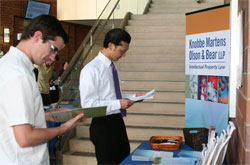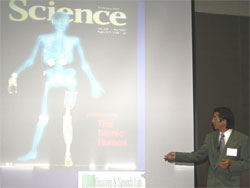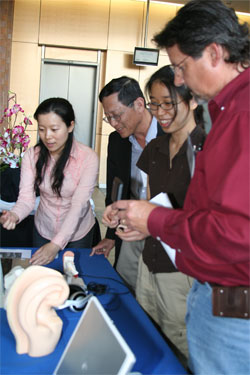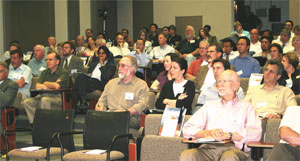Bionic Human Draws Capacity Crowd
By Anna Lynn Spitzer
|
Irvine, Calif. May 23, 2008 -- More than 100 guests peeked into the future last week as Calit2@UCI hosted the “The Bionic Human,” the most recent Igniting Technology event.
The Igniting Technology series, sponsored by intellectual property law firm Knobbe Martens Olson & Bear LLP, offers attendees a birds-eye view of research underway in Calit2-affiliated labs on the Irvine campus. Each event also gives local companies and researchers an opportunity to demonstrate their wares.
The Bionic Human, moderated by KMOB partner Bill Bunker, featured four UC Irvine researchers working on innovative technologies that combine biology and electronics, as well as a venture capitalist who addressed the commercial aspects of innovation.
|
The researchers included Mark Bachman, who is developing a sixth sense he calls XSense; Jeff Fisher, who is creating a sensor-laden bionic hand; Hamid Djalilian, a surgeon crafting an auxiliary balance system; and Fan-Gang Zeng, whose groundbreaking signal-processing research is improving effectiveness in cochlear implants.
Experienced venture capitalist Bob Molinari shared tips for turning intriguing research into marketable products.
Creating a New Sense
Bachman, whose research is based on sensory substitution, uses sensors and actuators to create devices that teach people to recognize sensations they cannot see or hear. “If someone has lost their hearing or sight or balance, we use electronics and mechanical systems to replace or restore that,” he said. “But what if we went beyond that and actually augmented existing senses instead?”
Sensors on the XSense device detect movement, heat, or other sensations, sending an electronic signal – a vibration, for example – to a specific nerve. The stimulus is then converted into electrical impulses that the brain can recognize. Bachman said the first few times, the user recognizes the stimulus. But after 10 or 20 times, he told the audience, “you no longer feel the vibration, you just feel something close to you. This is because of the concept of sensory substitution.”
The idea, hatched from his work with cochlear implants, could benefit the military. “If soldiers on the battlefield are looking at their instruments, they’re not looking at the rest of the environment. You need to have all your senses available when you’re in a hostile environment,” he said.
|
Bachman said the devices could also be used to assist those who have lost visual acuity, as well as for industrial, remote handling and transportation applications.
Next-Generation Prosthesis
Researcher Jeff Fisher, biomedical engineering graduate student, shared his efforts on the DARPA-sponsored Revolutionary Prosthetics Program, a four-year project that will produce a fully motor-and-sensory-functional upper limb that responds to direct neural control.
Fisher, along with UCI Prof. Abe Lee, is working on the limb’s fingertip sensors, which will be integrated into a skin-like covering and will allow wearers to feel heat and cold, grasp tools, and shake hands.
He explained that human skin contains many different types of sensors. “We have sensors that encode for skin stretch, pressure, vibration, thermal – there is quite a range,” he said. “We’re trying to replicate that on a single, common platform.”
He and Lee are experimenting with microfluidics – the movement of fluids through tiny channels – in the pressure and vibration sensors, and with electric fields in the proximity sensors.
Multiple sensors will make the hand more lifelike, but all that information can lead to processing bottlenecks. So researchers are developing a theoretical framework that will allow them to optimize the kind of information transmitted back to the wearer, Fisher explained. They are breaking down behaviors into sub-goals and determining sensor functionalities that are required to perform specific tasks.
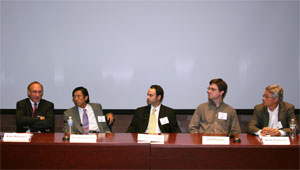 “Even something as simple as grabbing a coffee cup involves many sub-goals that require a whole range of senses to enable them,” he explained.
“Even something as simple as grabbing a coffee cup involves many sub-goals that require a whole range of senses to enable them,” he explained.
“When you give this prosthetic to a user, he doesn’t care about the fancy sensors and how many years of research went into it, he wants to know what kind of activities is this (hand) going to enable me to do in my daily life?”
|
Augmenting Balance
When head and neck surgeon Hamid Djalilian is not in the operating room, he is conducting research on devices to augment deficient balance systems. “Falls are the leading cause of injury-related death among the elderly and a leading cause of injury-related visits to the emergency room,” he said. “So we want to prevent falls, but how do we control our balance?”
There are two ways, Djalilian said. One is an implantable vestibular prosthesis that contains sensors, a circuit system and electrodes. It detects deviations in balance and sends the necessary signals to the brain. UCI professor Andrei Shkel is developing the mechanism, which is still several years from market.
The other approach is a wearable device that incorporates sensory stimulation and feedback to retrain the brain to provide balance. Early versions of the device use a gyroscope to detect tilt and electrodes to deliver stimulation to the patient, thus retraining the brain to recognize these signals.
Djalilian wants to include more than just tilt information. “We are trying to deliver all the information we currently get from the inner ear,” he said. “We also want to make these devices wireless and one of the benefits here at UCI is our miniaturization capability.”
Improving Cochlear Implants
Fan-Gang Zeng is developing novel speech-processing mechanisms that will drastically improve cochlear implants, the tiny devices also known as bionic ears.
He played audio for the audience that replicated what a deaf person using the earliest cochlear implants would have heard. Reminiscent of bursts of air and static, the words were nearly impossible to comprehend. “Those early devices, which contained only one electrode, enabled people to read lips better and to be aware of environmental sounds like the knock on a door or the ring of a telephone,” Zeng said.
By contrast, today’s implants contain 22 electrodes, which allow patients to recognize about 80 percent of speech, including different pitches, in quiet situations. Wearers can understand enough to carry on telephone conversations, and deaf children wearing the devices can develop normal language.
There is still much to be done, however. The devices are expensive and power-hungry, and do not provide perfect hearing. Zeng played a musical excerpt as it would be heard by a cochlear implant user. The sound was fuzzy, the melody indiscernible. After playing the same excerpt as a hearing person would perceive it told the audience, “I guess you get the point. You can appreciate the gap we have to bridge.”
Zeng’s plans to improve quality while lowering the cost of the implant with off-the-shelf components. “We are going to make it completely implantable, even the microphone, and we may even combine it with the vestibular implant,” he added.
A Business View
Self-proclaimed “mentor capitalist” Bob Molinari, a member of the Life Science Angels and a principal at MedStars Inc., discussed ways to successfully move research from the lab into the marketplace.
“What new companies need is often very different from what granting agencies need,” he said. “Your business plan may look interesting but may not make sense in the real world.”
Investors are interested in the rate of return, he said, and with health care costs out of control, it’s important to look past the technology to a product’s cost effectiveness. Another tip to entrepreneurs: address the hot trends, which currently include metabolic and neurologic diseases. “Cancer is out,” he told the group. “I can’t tell you how many times we’ve cured cancer in mice; we still have a problem in humans.”
Device deals still “plug along,” he said, but it costs $20-50 million to introduce a new device to market. The big players in the industry – Medtronics, Boston Scientific and Johnson & Johnson “tend to do without technology if it costs too much,” he explained, returning to his theme of cost effectiveness. “The healthcare system still hasn’t figured out how to deal with preventative care in a very cost-effective way.”
.


